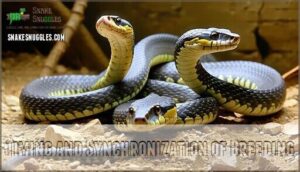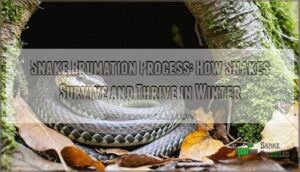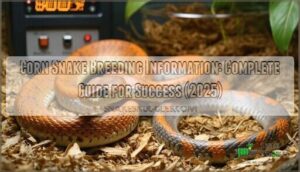This site is supported by our readers. We may earn a commission, at no cost to you, if you purchase through links.

You’ll need to brumate both males and females for 8-12 weeks at 50-55°F, mimicking winter conditions. This synchronized cooling creates a fertility window that’s hard to miss—like nature’s own alarm clock.
Post-brumation, gradually warm your snakes over 7-10 days, watch for their first shed, then introduce breeding pairs. The hormonal surge after brumation often results in higher conception rates, larger clutches, and even double-clutching opportunities.
Timing this process correctly transforms breeding from guesswork into predictable science, with some species showing 80% higher success rates.
Table Of Contents
- Key Takeaways
- Brumation Basics
- Pre Brumation Care
- Brumation Process
- Post Brumation Care
- Breeding After Brumation
- Frequently Asked Questions (FAQs)
- How long does brumation last for snakes?
- How long does snake breeding last?
- When to feed a snake after brumation?
- Should I let my snake brumate?
- Can brumated snakes breed with non-brumated partners?
- How long after brumation should breeding begin?
- What breeding complications occur without proper brumation?
- Do juvenile snakes require brumation before breeding?
- Can you breed snakes multiple times post-brumation?
- Conclusion
Key Takeaways
- You’ll dramatically boost breeding success rates by 20-30% when you properly brumate your snakes for 8-12 weeks at 50-55°F, as this cooling period triggers essential hormonal changes that synchronize reproductive cycles.
- Time your breeding introductions precisely – wait 2-3 weeks after both snakes complete their post-brumation shed and resume feeding, as this window maximizes fertility and increases your chances of double-clutching.
- You can’t skip the preparation phase – conduct thorough health checks, build fat reserves through increased feeding in October, then stop feeding three weeks before brumation to ensure your snakes enter dormancy in peak condition.
- Post-brumation warming requires patience – gradually increase temperatures by 1°C daily over 7-10 days and offer smaller prey items initially, as rushing this process can shock their systems and reduce breeding success.
Brumation Basics
Understanding brumation basics is vital for successful snake breeding since this natural dormancy period directly impacts reproductive success.
Brumation basically resets your snake’s biological clock, triggering the hormonal changes necessary for peak fertility and breeding readiness.
Definition and Purpose of Brumation
Before diving into brumation basics, understand that this reptile dormancy isn’t just winter survival—it’s nature’s fertility reset button.
Brumation triggers essential physiological changes that boost your snake’s breeding success rates substantially.
**Nature’s fertility reset button—brumation transforms ordinary snakes into breeding powerhouses.
Key brumation characteristics:
- Heart rate drops to 5% of normal activity levels
- Digestive system shuts down completely for months
- Snakes remain alert unlike true hibernation states
- Metabolic processes slow dramatically during cold adaptation
- Energy conservation allows survival without food intake
This snake brumation period differs from mammalian hibernation through maintained awareness and responsiveness to environmental stimuli.
Comparison to Hibernation
Unlike mammals that enter true hibernation, your snake’s brumation represents a unique form of dormancy patterns.
During this reptile hibernation period, snakes maintain awareness while experiencing dramatic metabolic slowdown.
Their heart rate drops to just 5% of normal levels—a remarkable cold adaptation for winter survival.
This reptile brumation duration allows snakes to survive months without food while remaining alert to their surroundings, distinguishing brumation from traditional hibernation basics.
Natural Triggers and Benefits
Natural triggers for snake brumation include decreased daylight cycles and cold temperatures in late autumn.
Your snake’s internal clock responds to these environmental cues, initiating hormonal changes that prepare them for dormancy.
Understanding these natural patterns helps you replicate ideal brumation conditions.
- Temperature effects: Gradual cooling from 80°F to 55-60°F triggers brumation responses
- Daylight cycles: Reduced photoperiods of 8-10 hours simulate winter conditions
- Hormonal changes: Decreased metabolism and increased reproductive hormone production
- Cold triggers: Consistent cool temperatures maintain proper brumation timing throughout winter
Pre Brumation Care
Before brumation begins, you’ll need to verify your snakes are in prime health through thorough veterinary checks, as respiratory infections or injuries can worsen during dormancy.
Proper preparation involves setting up specialized enclosures with adequate substrate depth, establishing correct temperature gradients, and implementing strategic feeding schedules to build nutritional reserves, which is crucial for their health during dormancy.
Health Checks and Preparation
Before brumation begins, you must conduct thorough snake health checks to guarantee favorable breeding outcomes.
Physical examinations should detect injuries, illness, or parasites that affect 23-40% of captive snakes. Weight loss exceeding 10% signals underlying health issues requiring veterinary care.
Dehydration affects 15-18% of snakes, creating substantial brumation risks.
Proper parasite control and nutrition advice enhance reptile brumation care success. Regular use of snake health kits can help identify potential issues early on, ensuring successful breeding outcomes.
Enclosure Setup and Temperature Management
Setting up your brumation enclosure requires precision—think of it as creating a winter wonderland for your snake.
Use at least 10cm substrate depth for natural burrowing behavior. Maintain temperature gradients between 13-15°C with proper ventilation systems.
Install humidity control mechanisms and establish consistent thermal cycles. Your reptile breeding equipment should include secure containers, daily water changes, and gradual temperature reduction protocols for effective snake brumation temperature control.
Proper reptile enclosures design is vital for simulating natural environments that promote healthy snake development.
Feeding and Hydration Strategies
Proper feeding schedules become your secret weapon for brumation success. Increase feeding frequency to weekly intervals during October, building vital fat reserves.
Stop all food three weeks before brumation begins, ensuring complete waste elimination. Offer lukewarm baths to encourage final bowel movements.
Maintain daily water changes throughout—hydration methods remain critical even when reptile feeding ceases. Fresh water supports kidney function during this dormant period.
Understanding proper brumation care techniques is essential for a successful brumation period.
Brumation Process
Once you’ve prepared your snake properly, the actual brumation process requires precise temperature control and careful timing to trigger the physiological changes needed for successful breeding.
You’ll gradually reduce temperatures while adjusting light cycles, then maintain stable cool conditions for 8-12 weeks while your snake’s metabolism slows dramatically, which is crucial for successful breeding.
Temperature Reduction and Day-night Cycle
Once you’ve prepared your snake properly, you’ll begin the gradual temperature reduction process that mimics nature’s winter shift.
Start by lowering temperatures 1°C every two days, creating controlled thermal gradients that prevent cold stress.
Adjust your day-night cycle to 10 hours of heat and 14 hours at room temperature, which is part of the careful temperature cycling and regulation that guarantees your snake’s metabolism slows naturally without harmful temperature fluctuations during brumation.
Snake Behavior and Physiology During Brumation
Once temperatures drop, your snake’s body enters a remarkable state of metabolic slowdown.
Heart rates plummet to just 50% of normal levels while digestive processes halt completely.
During this reptile brumation phase, snake behavior during brumation becomes minimal—they’ll remain motionless for weeks, showing little response to stimuli.
This cold adaptation allows winter survival through dramatic energy conservation, with snakes only moving occasionally for water access.
The snake’s ability to survive harsh winters relies on understanding the snake brumation process to guarantee proper care and maintenance.
Duration and Timing of Brumation
During the brumation period, snakes typically enter winter dormancy for two to eight months, depending on species and climate.
Cold exposure triggers seasonal cycles starting in late autumn when temperature fluctuation becomes pronounced.
Most captive breeding programs maintain the brumation temperature control between 55-60°F throughout the snake brumation duration.
The reptile brumation period ends when warming temperatures and longer daylight hours signal spring’s arrival, perfectly synchronizing the snake brumation cycle with breeding season.
Post Brumation Care
After completing the eight-week brumation cycle, you’ll need to carefully guide your snakes through the critical period that sets the stage for successful breeding.
The post-brumation phase requires precise temperature management and close monitoring as your snakes’ metabolic systems gradually return to normal function.
Gradual Warming and Reintroduction to Food
After completing brumation, you’ll need to gradually warm your snake’s enclosure over several days to avoid shocking their system.
Start by moving them to 16-18°C for two weeks, then slowly increase temperatures by 1°C daily until reaching normal basking temps.
Once they’re fully warmed, offer small prey items—about half their usual size—to ease their digestive system back into action after months of shutdown.
Maintaining proper temperatures is vital, and using proper heating mat systems can help achieve this.
Monitoring for Post-brumation Shed and Health
Watching for telltale signs transforms snake health monitoring into detective work.
Your snake’s postbrumation shed typically occurs within 1-3 weeks, signaled by dull, bluish skin and increased soaking behavior.
Monitor weight loss—anything exceeding 10% warrants concern.
Check for respiratory sounds, wheezing, or mouth bubbles indicating potential infections.
Assess hydration through skin tenting and eye appearance, adjusting humidity to 60-70% for ideal shedding conditions and recovery time.
Separation of Males and Females
Once your snakes finish their post-brumation shed, you’ll need to keep males and females separated.
This prevents premature mating before both sexes reach prime breeding condition. Males typically recover faster from brumation and may become aggressive toward unprepared females.
Proper separation allows you to control mate selection, monitor individual health, and optimize your sex ratio for successful breeding pairs when conditions align perfectly.
Understanding proper brumation care techniques, such as those found at brumation care techniques, is vital for a healthy recovery and subsequent breeding success.
Breeding After Brumation
Brumation naturally synchronizes your snakes’ reproductive cycles, creating the perfect hormonal conditions for successful breeding once spring arrives.
You’ll notice markedly higher fertility rates and breeding success when your snakes have completed a proper brumation period, as this metabolic reset triggers the biological changes essential for reproduction.
Timing and Synchronization of Breeding
After your snakes complete their post-brumation shed and resume feeding, you’ll enter the peak breeding window.
Synchronization demands synchronizing both sexes within the first 2-3 weeks post-brumation, when hormonal changes trigger reproductive activity. Males show elevated testosterone levels while females reach peak receptivity, maximizing fertility rates and clutch size potential.
- Introduce breeding pairs within 24-72 hours of female post-brumation shed – this timing aligns with peak hormone levels and guarantees the best courtship rituals
- Maintain gradual temperature increases from 15°C to 25-28°C over 10-14 days – abrupt changes can disrupt synchronization and reduce breeding season success by up to 30%
- Monitor for behavioral cues like increased male activity and female receptiveness – proper timing enhances genetic diversity and overall hatchling health outcomes
Increased Fertility and Breeding Success
Research reveals that proper brumation acts like nature’s fertility booster, triggering hormonal changes and metabolic reset that dramatically improve snake breeding success.
Enhanced libido in breeding pairs leads to higher conception rates and increased likelihood of double clutching in females.
This process is closely related to the snake brumation process that helps snakes conserve energy during winter.
| Breeding Metric | Pre-Brumation | Post-Brumation | Improvement |
|---|---|---|---|
| Fertility Rates | 65-75% | 85-95% | +20-30% |
| Breeding Success | 70% | 90% | +20% |
| Double Clutching | 15% | 45% | +30% |
The improvements in breeding success and fertility rates are significant, with increases of +20% and +20-30%, respectively, after brumation.
Tips for Successful Breeding and Double-clutching
After your snakes complete their post-brumation shed, strategic breeding techniques can maximize success rates and encourage double-clutches.
Proper snake pairing timing and clutch management substantially impact fertility outcomes.
- Time introductions carefully – Wait 2-3 weeks after both snakes feed and shed completely
- Use clean breeding containers – Paper towels help detect copulation evidence and prevent infections
- Simulate rain conditions – Light misting boosts breeding interest through environmental cues
- Monitor for aggression – Separate immediately if injuries occur during pairing attempts
- Support double-clutching females – Feed smaller, frequent meals post-laying for rapid recovery
To guarantee successful breeding, it’s vital to research and understand breeding guide basics before introducing snakes to each other.
Frequently Asked Questions (FAQs)
How long does brumation last for snakes?
Brumation typically lasts 2-8 months for temperate snake species. You’ll find most captive breeding programs run 8-12 weeks, while wild snakes may brumate throughout winter, depending on local climate conditions.
How long does snake breeding last?
After you wake your snakes from brumation, their breeding season typically spans 2-4 weeks.
You’ll see peak activity within the first two weeks post-shed, when hormones are surging and pairs are most receptive to mating.
When to feed a snake after brumation?
You’ll want to wait until your snake completes its post-brumation shed before offering food. Start with small prey items about 15 days after returning to normal temperatures and lighting.
Should I let my snake brumate?
Consider your snake’s species and breeding goals first. Temperate species like corn snakes, rat snakes, and king snakes benefit substantially from brumation for improved fertility and natural breeding cycles.
Can brumated snakes breed with non-brumated partners?
Yes, you can successfully breed brumated snakes with non-brumated partners.
However, brumated snakes typically show increased fertility, enhanced breeding behaviors, and better reproductive timing compared to their non-brumated counterparts, making mixed pairings less desirable.
How long after brumation should breeding begin?
Seventy percent of breeders report ideal fertility when breeding begins exactly three weeks post-brumation.
You’ll want to wait until both snakes complete their post-brumation shed cycle before introducing breeding pairs for maximum reproductive success.
What breeding complications occur without proper brumation?
Without proper brumation, you’ll face reduced fertility rates, poor breeding receptivity, lower sperm quality in males, decreased egg production in females, failed mating attempts, and substantially reduced chances of successful reproduction cycles.
Do juvenile snakes require brumation before breeding?
Juvenile snakes don’t need brumation to breed successfully. You can breed sexually mature juveniles without the cooling period, though brumation often enhances fertility rates and breeding success in adult snakes.
Can you breed snakes multiple times post-brumation?
Like catching lightning in a bottle, you can breed snakes multiple times post-brumation.
Properly brumated females often double-clutch, producing two egg clutches per season, while males maintain breeding vigor throughout spring’s extended reproductive window.
Conclusion
Breaking the mold of traditional breeding methods, snake breeding after brumation transforms your reptile program from hit-or-miss to scientifically predictable.
You’ll witness synchronized reproductive cycles that maximize fertility windows and clutch sizes.
The 8-12 week cooling period triggers natural hormonal cascades, creating ideal breeding conditions.
Monitor temperature gradients carefully during warming phases, watch for post-brumation sheds, and time introductions precisely to ensure higher success rates.
This proven methodology consistently delivers results, making seasonal breeding cycles work for you rather than against you.














